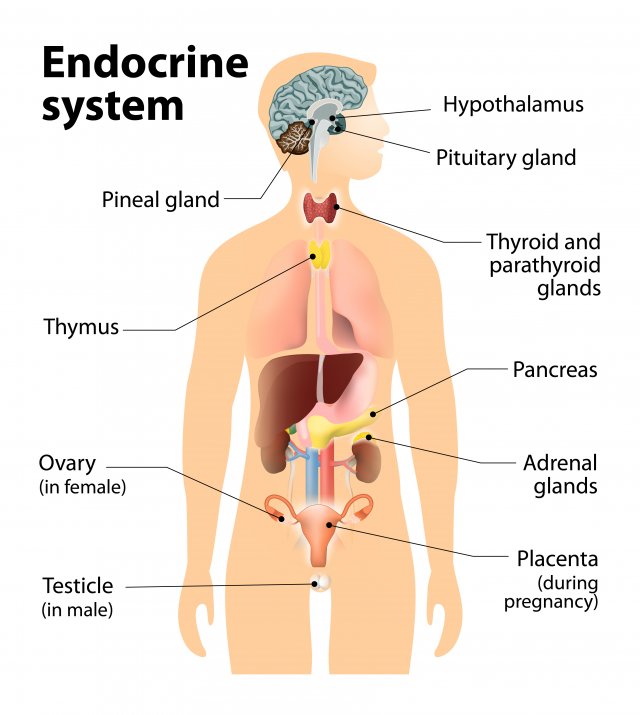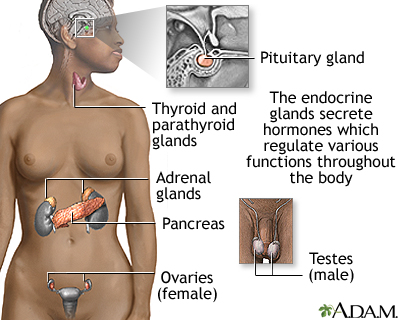Endocrine systems, also referred to as hormone systems, are found in all mammals, birds, fish, and many other species.

The endocrine system consists of:
- Glands located throughout the body;
- Hormones made by the glands and released into the bloodstream or the fluid surrounding cells; and
- Receptors in various organs and tissues that recognize and respond to the hormones.
What is a Gland ?
In animals, a gland is a group of cells in an animal’s body that synthesizes substances (such as hormones) for release into the bloodstream (endocrine gland) or into cavities inside the body or its outer surface
Exocrine glands are specialized structures that release substances onto the surface of epithelial tissues through ducts. Examples of exocrine glands include sweat, salivary, mammary, ceruminous, lacrimal, sebaceous, prostate, and mucous glands. Exocrine glands are one of the two main types of glands in the human body, the other being endocrine glands, which discharge their products directly into the bloodstream.
Notably, the liver and pancreas are considered both exocrine and endocrine glands. They function as exocrine glands by releasing products like bile and pancreatic juice into the gastrointestinal tract via ducts and as endocrine glands by secreting various substances directly into the bloodstream. Within the integumentary system, exocrine sweat glands consist of eccrine and apocrine types.
How Many Types of Glands Are There ?
Glands can be classified into several different types based on their structure, function, and mode of secretion. The main types of glands include:
- Exocrine Glands: These glands secrete their products into ducts, which then carry the secretions to a specific location, often a body surface or cavity. Exocrine glands can be further classified into various subtypes based on their secretions:
- Serous Glands: Produce a watery, enzyme-rich secretion. Examples include salivary glands and certain sweat glands.
- Mucous Glands: Produce a thicker, mucus-rich secretion. Examples include goblet cells in the respiratory and digestive tracts.
- Mixed Glands: Contain both serous and mucous cells. Examples include the submandibular salivary glands.
- Endocrine Glands: These glands are ductless and release hormones directly into the bloodstream. Hormones are chemical messengers that regulate various physiological processes throughout the body. Examples include the pituitary gland, thyroid gland, adrenal glands, and pancreas.
- Holocrine Glands: Holocrine glands secrete their products by rupturing and destroying the entire gland cell. The secretory cells accumulate their product until they burst, releasing it along with cellular debris. Sebaceous (oil) glands in the skin are an example of holocrine glands.
- Merocrine Glands: Merocrine glands release their secretions via exocytosis, where the secretory vesicles fuse with the cell membrane, releasing the product without destroying the cell itself. Sweat glands and salivary glands are examples of merocrine glands.
- Apocrine Glands: Apocrine glands release their secretions by pinching off a portion of the cell membrane, along with the product, which contains cellular and lipid components. Apocrine sweat glands in certain areas of the body are examples.
- Sebaceous Glands: These glands are a type of holocrine gland that produces sebum, an oily substance that lubricates the skin and hair.
- Mammary Glands: These glands are specialized sweat glands that produce milk in response to hormonal stimulation. They are found in the breasts of females and are involved in lactation.
- Pineal Gland: The pineal gland is a small endocrine gland located in the brain. It produces melatonin, a hormone that regulates sleep-wake cycles and plays a role in circadian rhythms.
- Parathyroid Glands: These are four small endocrine glands located behind the thyroid gland. They produce parathyroid hormone, which regulates calcium and phosphate levels in the blood.
- Thymus Gland: The thymus is an endocrine gland located in the upper chest. It plays a crucial role in the development and maturation of T lymphocytes (a type of white blood cell) and the immune system.
These are some of the main types of glands in the human body, each with its own specific function and mode of secretion.
What Are Exocrine Glands ?
Exocrine glands are a type of gland in the body that secrete their products (substances or fluids) into ducts, which then transport these secretions to specific locations within the body, often to a body surface or cavity.
The function of exocrine glands in the body varies depending on their location and the organ system they are associated with. However, their main function is to produce secretions that are released through a duct system onto an epithelial surface. These secretions serve various purposes, including aiding in food digestion, providing mucosal protection, assisting in thermoregulation, offering lubrication, and contributing to nutrition.
Exocrine glands are responsible for producing a wide variety of substances that play important roles in digestion, protection, temperature regulation, and more.
Here are some key points about exocrine glands:
- Duct System: Exocrine glands are characterized by the presence of ducts, which are tiny tubes or passageways that connect the glandular cells to the target location where the secretions are needed.
- Types of Secretions: Exocrine glands can produce various types of secretions, including:
- Serous Secretions: These secretions are typically thin, watery, and enzyme-rich. Examples include the serous cells of salivary glands that produce saliva to aid in digestion.
- Mucous Secretions: These secretions are thicker and contain mucus, a slimy substance. Goblet cells in the respiratory and digestive tracts are an example of mucous-secreting cells.
- Mixed Secretions: Some exocrine glands contain both serous and mucous cells, resulting in mixed secretions. An example is the submandibular salivary gland, which produces a combination of serous and mucous saliva.
- Locations: Exocrine glands are found throughout the body and are associated with various organ systems. For example:
- Salivary glands in the mouth produce saliva.
- Sweat glands in the skin produce sweat to help regulate body temperature.
- Sebaceous glands in the skin produce sebum, an oily substance that lubricates the skin and hair.
- Pancreatic exocrine glands release digestive enzymes into the small intestine to aid in digestion.
- Functions: The secretions produced by exocrine glands serve a range of functions, including:
- Digestion: Enzymes produced by exocrine glands in the digestive system help break down food.
- Lubrication: Exocrine glands produce substances that lubricate various surfaces, such as the mucous secretions that line the respiratory and digestive tracts.
- Protection: Mucus secretions can trap and remove pathogens and foreign particles from the body.
- Cooling: Sweat produced by sweat glands helps regulate body temperature through evaporative cooling.
- Regulation: Exocrine gland activity is often regulated by nervous and hormonal signals. For example, salivary gland secretion is stimulated when we eat or anticipate eating, and sweat gland activity increases in response to heat or exercise.
Mechanism of Exocrine Glands:
The three mechanisms by which exocrine glands release their secretions include merocrine, apocrine, and holocrine.
- Merocrine glands are the most common subtype. By definition, merocrine gland secretions exit the cell via exocytosis. In this method of secretion, there is no cell damage. An example of merocrine secretion is the eccrine sweat gland.
- Apocrine glands, in contrast, form buds of the membrane which break off into the duct, losing part of the cellular membrane in the process. A well-known apocrine gland is the breastmilk-producing mammary gland.
- The final subtype of excretion is holocrine, in which the cellular membrane ruptures to release its product into the duct. Sebaceous glands are a representation of holocrine secretion.

What Are Endocrine Glands?
Endocrine glands are a type of glandular tissue in the body that produce and release hormones directly into the bloodstream. These hormones are chemical messengers that travel throughout the body to target cells or organs, where they regulate various physiological processes and maintain homeostasis. Endocrine glands are a vital component of the endocrine system, which plays a crucial role in controlling and coordinating a wide range of bodily functions.
Key characteristics and features of endocrine glands include:
- Ductless Structure: Unlike exocrine glands, which have ducts to transport their secretions to specific locations, endocrine glands lack ducts. Instead, they release hormones directly into the bloodstream, allowing these hormones to reach distant target tissues and organs.
- Hormone Production: Endocrine glands produce a variety of hormones, each with specific functions. These hormones include insulin, thyroid hormones, growth hormone, adrenaline, and many others.
- Regulation of Physiological Processes: Hormones produced by endocrine glands play essential roles in regulating numerous physiological processes, including metabolism, growth and development, immune function, reproduction, and response to stress.
- Feedback Mechanisms: Hormone secretion by endocrine glands is typically controlled by feedback mechanisms. Negative feedback loops help maintain hormone levels within a narrow, optimal range. When hormone levels rise or fall beyond this range, feedback mechanisms signal the glands to adjust their hormone production accordingly.
- Examples of Endocrine Glands: Some of the major endocrine glands in the human body include:
- Pituitary Gland: Often referred to as the “master gland,” the pituitary gland is located at the base of the brain and controls the function of several other endocrine glands. It secretes hormones that regulate growth, thyroid function, adrenal function, and more.
- Thyroid Gland: The thyroid gland produces hormones that control metabolism and energy balance.
- Adrenal Glands: The adrenal glands, located on top of each kidney, secrete hormones like adrenaline (epinephrine) and cortisol, which are involved in the body’s response to stress.
- Pancreas: The pancreas serves a dual role as both an exocrine and an endocrine gland. It produces insulin and glucagon, which regulate blood sugar levels.
- Feedback Loops: Many endocrine glands are regulated by negative feedback loops, ensuring that hormone levels remain within a narrow, optimal range. When hormone levels deviate from this range, feedback mechanisms signal the glands to either increase or decrease hormone production to restore balance.
In summary, endocrine glands are critical for maintaining the body’s internal balance and regulating various physiological processes through the secretion of hormones into the bloodstream.
Where are Endocrine Glands Located in the Human Body?

Hypothalamus – The hypothalamus links our endocrine and nervous systems together. The hypothalamus drives the endocrine system.
Pituitary gland – The pituitary gland receives signals from the hypothalamus. This gland has two lobes, the posterior and anterior lobes. The posterior lobe secretes hormones that are made by the hypothalamus. The anterior lobe produces its own hormones, several of which act on other endocrine glands.
Thyroid gland – The thyroid gland is critical to the healthy development and maturation of vertebrates and regulates metabolism.
Adrenal glands – The adrenal gland is made up of two glands: the cortex and medulla. These glands produce hormones in response to stress and regulate blood pressure, glucose metabolism, and the body’s salt and water balance.
Pancreas – The pancreas is responsible for producing glucagon and insulin. Both hormones help regulate the concentration of glucose (sugar) in the blood.
Gonads – The male reproductive gonads, or testes, and female reproductive gonads, or ovaries, produce steroids that affect growth and development and also regulate reproductive cycles and behaviors. The major categories of gonadal steroids are androgens, estrogens, and progestins, all of which are found in both males and females but at different levels.